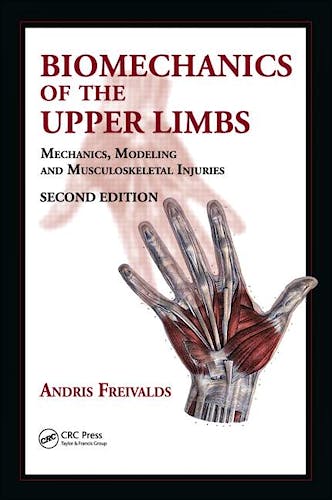

No hay productos en el carrito



Biomechanics of the Upper Limbs: Mechanics, Modeling and Musculoskeletal Injuries
Freivalds, A.
2ª Edición Marzo 2011
Inglés
Tapa dura
564 pags
1400 gr
18 x 25 x 3 cm
ISBN 9781420091199
Editorial CRC PRESS
LIBRO IMPRESO
-5%
194,70 €184,96 €IVA incluido
187,21 €177,85 €IVA no incluido
Recíbelo en un plazo de
2 - 3 semanas
Description
There is already a wealth of literature covering cumulative trauma disorders and medical management, as well as the biomechanics of manual material handling and lower back problems. However, despite a spike in the number of work-related musculoskeletal disorders (WRMSDs) in the upper limbs—due to a sharp increase in the amount of computer-related jobs—few if any books have focused exclusively on WRMSDs, until now.
Biomechanics of the Upper Limbs: Mechanics, Modeling and Musculoskeletal Injuries, Second Edition offers vital information and tools to improve analysis of external forces and their effects on the human body. This can help ergonomists better understand job stressors and the role they play in the development of disorders, enabling them to modify the work environment and educate practitioners to better control harmful situations.
Using the author’s medical and engineering expertise to distill essential subject matter and useful technical data, this comprehensive text explores:
- Biomechanics of the upper limbs and the motor control system
- The structure and physiology of the human musculoskeletal and neuromuscular systems
- Recent research findings and solutions to various ergonomic problems
- Models of various components of the neuromuscular systems, as well as larger systems in the upper limbs
- Risk factors for disorders and tools used to identify their causes
Designed as a textbook for a typical semester-long graduate-level engineering or kinesiology course, this book includes a link to an ancillary website that offers materials such as PowerPoint® slides, sample exams, and an instructor's manual with complete solutions. It also serves as a practical, up-to-date, engineering-oriented resource for researchers, industrial ergonomists, industrial hygienists, and medical professionals who require supplementary material.
Features
- Provides numerous examples in each chapter
- Features downloadable Power Point slides, sample exams, and other background material on a supporting website
- Includes an instructor's manual with complete solutions
- Contains end-of-chapter references to enhance further study
Table of Contents
- Introduction to Biomechanics
- What Is Biomechanics?
- Basic Concepts
- Coordinate Systems
- Force Vector Algebra
- Static Equilibrium
- Anthropometry and Center of Mass Determination
- Friction
- Dynamics
- Structure of the Musculoskeletal System
- Gross Overview of Movements
- Skeletal System
- Mechanical Properties of Bone
- Soft Connective Tissue
- Joints
- Neuromuscular Physiology and Motor Control
- Introduction to Musculature
- Structure of Muscle
- Basic Cell Physiology
- Nervous System
- Excitation–Contraction Sequence
- Motor Units
- Basic Muscle Properties (Mechanics)
- Energy, Metabolism, and Heat Production
- Receptors
- Reflexes and Motor Control
- Modeling of Muscle Mechanics
- Laplace Transforms and Transfer Functions
- Viscoelastic Theory
- Hill’s Muscle Models
- Frequency Analysis
- Frequency Analysis of Passive Muscle
- Hatze’s Multielement Model
- Applications of the Hatze Muscle Model
- Control Theory and Motor Control
- Root-Locus Approach to Muscle Modeling
- Models of the Upper Limbs
- Anatomy of the Hand and Wrist
- Static Tendon-Pulley Models
- Dynamic Tendon-Pulley Models
- Complex Tendon Models
- Two-Dimensional Hand Model
- Direct Measurement Validation Studies
- Critical Evaluation of Modeling Approaches
- Musculoskeletal Disorders and Risk Factors
- Extent of the Problem
- Common Musculoskeletal Disorders and Their Etiology
- Medical Diagnosis and Treatment of MSDs
- Epidemiologic Approach to MSDs
- Scientific Research and Evidence for Occupational Risk Factors
- Scientific Research and Evidence for Psychosocial Risk Factors
- Iatrogenesis: A Contrarian View
- Legal Issues
- Instrumentation
- Introduction
- Wrist- and Finger-Motion Measurements
- Pressure- and Force-Distribution Measurements
- Nerve-Conduction Measurements
- Electromyography
- Job and Worksite Analysis
- The Need for Job Analysis
- Reliability and Validity of Assessment Tools
- Initial Identification of Musculoskeletal Injury Problems
- Gross Posture and Task Analyses
- Quantitative Upper Limb WRMSD Risk-Assessment Tools
- Data-Driven Upper Limb WRMSD Risk Index
- Hand Tools
- Introduction
- General Biomechanical Considerations of Tools
- Handles for Single-Handled Tools
- Handles for Two-Handled Tools
- Other Tool Considerations
- Agricultural and Forestry Tools
- Industrial Tools
- The Office Environment
- General Musculoskeletal Problems
- Seated Workplace
- Keyboard
- Mouse and Other Cursor-Positioning Devices
- Notebooks and Handheld PCs
- Interventions for Office Work
© 2026 Axón Librería S.L.
2.149.0